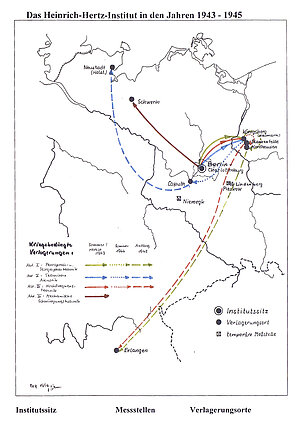1943-1945
The institution building of the Heinrich-Hertz-Institut in Franklinstraße suffered a number of damages during the war years due to bomb attacks. The damages could be repaired initially, which made it possible for the Institute to remain operational. From August 1943, though, the number of air raids increased so that it was decided to relocate parts of the Institute to less endangered regions. Due to that, the HHI was forced to travel.
According to Prof. Heinz Jungfer (who worked at the Technische Universität Berlin since 1942 and had a secondary employment at the HHI), the shipment of the packaged components of departments I to III took place mainly by water route in 1943. The Landwehr Canal was situated directly next to the institute building at Franklinstraße, which made it possible to load the cargo directly onto ships and to transport them to an embarkation point on the Oder, close to the city of Königsberg in Neumark (now Poland).
The main portion of the equipment of Department IV (Mechanical Vibration Technology) was sent to Schwerin in Mecklenburg a little later.
A number of further relocations to alternative locations would follow, mostly by train. But it was difficult to find suitable premises. An airbase was used sometimes, a farmhouse or an old factory at other times.
It also happened that previously selected locations could not be used anymore due to bomb damage. Not all shipments were able to reach their destination and some even remained lost. In some instances, alternative locations were evacuated, because in the meantime the situation escalated in those areas as well, like in Caputh near Potsdam. The inventory that has been outsourced there during the summer had to be moved to Pelzerhaken near Neustadt in Schleswig-Holstein in the beginning of 1945. The former employee Helmut Senger, who was involved in this, described the details in a witness report:
“For the relocation to Pelzerhaken, all official and private inventory was loaded into freight cars, which were parked at the Caputh railway station and were to be transported to Neustadt. After some time, when there was no arrival notification from the wagons, Prof. Meyer sent Mr. Haberland and myself to the railroad track in the direction of Berlin, in order to locate the wagons. All major railway stations along the railway line from Neustadt to Caputh were searched for the freight cars. The search was in vain. Once in Caputh, we found the wagons still locked up standing on the sidetrack. After consultation with the responsible department at Potsdam railway station, we were informed that due to the frontline situation, there was no longer any possibility of transporting the freight.”
It is not known whether it was possible to clarify later on what happened to the wagons.
